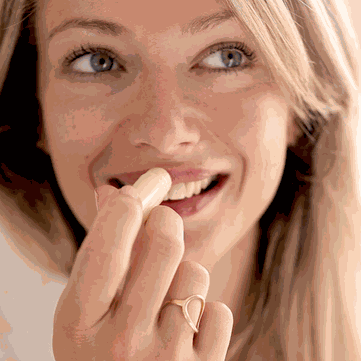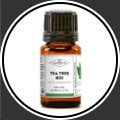The wind, cold and sun dry out the skin on our lips, which is particularly thin and sensitive to dehydration. To prevent or overcome chapping, irritations, cuts and cracks, nothing better than natural and very simple remedies based on shea butter, vegetable oils and essential oils. Non-aggressive, these remedies repair, protect and nourish the skin on your lips every day.
In this file, we offer you 4 express recipes to take care of your lips in all circumstances. We also list the best vegetable and essential oils to use as well as dietary advice and everyday tips to help you soften and soften dry and dehydrated skin.


Recipe for nourishing and protective balm for chapped lips for children and adults
Why we love it: Ultra-nourishing, it protects and repairs damaged lips for the whole family, young and old alike.
Ingredients :
- Calendula oil : 2 ml
- Shea Butter : 2,5 ml
- Beeswax : 1 g
- Vitamins E : 1 drop
Preparation: Melt your shea butter (so you can measure it easily) by placing the pot in a bowl of very hot water for 5 minutes. Melt the beeswax in a bain-marie. When it is almost melted, add the shea butter and calendula oil (so as not to heat them for too long). Remove the bowl from the bain-marie and add the vitamin E. Homogenize and transfer before cooling, into a stick (or a small pot) using a pipette. Leave to cool for a few hours in the refrigerator.
How to use it :
Use as desired all year round.Caution: None. Can be used in small children and babies over 6 months, pregnant and breastfeeding women or people at risk. Prefer the stick, more hygienic than the pot.

Gentle scrub recipe for sensitive or chapped lips.
Why we like it: Removes dead skin, gently softens and nourishes the lips. Without rinsing.
Ingredients :
- Coconut oil : 3,5 ml
- Beeswax : 1 g
- Icing sugar: 3 g
- Vitamins E : 1 drop
Preparation: Melt your coconut oil (so you can measure it easily) by placing the bottle in a bowl of very hot water for 5 minutes. Then melt the beeswax + coconut oil mixture in a bain-marie. Once everything has melted, remove the bowl from the bain-marie and add the vitamin E. Mix it then add the icing sugar before cooling. Mix again. Pour the mixture into a small jar. Leave to cool for a few hours in the refrigerator.
How to use it :
Gently massage the lips with a little of your preparation. Once a week maximum so as not to irritate sensitive lips.Caution: None. Can be used in small children from 3 years old, pregnant and breastfeeding women or people at risk.

Recipe for healing and repairing balm with essential oils for chapped lips
Why we love it: Healing, pain-relieving, antiseptic, restorative and hemostatic, it is THE ideal recipe for treating chapped, cut, irritated and cracked lips.
Ingredients :
- Lavender aspic essential oil : 3 drops
- Ladaniferous cistus essential oil : 2 drops
- Shea Butter : 3,5 ml
- Rosehip oil : 1 ml
- Vitamins E : 2 drops
Preparation: Melt your shea butter (so you can measure it easily) by placing the pot in a bowl of very hot water for 5 minutes. In a small pot, mix the melted shea butter, rosehip oil, vitamin E and essential oils. Homogenize before cooling. Leave to cool for a few hours in the refrigerator.
How to use it :
Apply a little balm 2 to 3 times a day to damaged lips until healed. When cracks and chapped skin are treated, apply a balm without essential oil for daily use.Precaution: Do not use in pregnant or breastfeeding women and children under 8 years old. Caution in people with epilepsy. Lavender aspic essential oil can be allergenic.

Healing and pain relief treatment for chapped skin and cracks
Why we like it: Very healing, very soothing and anti-inflammatory, this treatment is perfect for treating a persistent crack.
Ingredients :
- Lavender aspic essential oil : 8 drops
- Ladaniferous cistus essential oil : 16 drops
- Noble chamomile essential oil : 6 drops
- Calophyll vegetable oil : 4 ml
Preparation: Mix all the ingredients in a codigoutte bottle or in a 5 ml roll on bottle. Shake to mix the mixture well.
How to use it :
Apply 1 to 2 drops of this mixture 2 times a day VERY locally on the crack. Do not exceed 5 days of treatment. CAUTION: do not apply to the entire lips.Precaution: Do not use in pregnant or breastfeeding women and children under 8 years old. Caution in people with epilepsy. Lavender aspic essential oil can be allergenic.
Contraindications:
Essential oils are generally not recommended for pregnant women (during the entire pregnancy), breastfeeding women and children under 8 years old (12 years old for certain essential oils). Carefully read the contraindications for each essential oil.
These properties and methods of use do not constitute medical advice. For therapeutic use consult a doctor.

Why are our lips chapped?
In the majority of cases, the skin of our body continuously produces sebum thanks to its sebaceous glands. This sebum is a real protective lipid film, mainly made up of triglycerides and waxes. Its role is to prevent skin drying by forming a protective barrier on its surface.
BUT… Our lips do not have sebaceous glands… they therefore cannot easily protect themselves from external climatic aggressions. In addition, their skin is very thin, which further reinforces their tendency to dry, crack and crack.
Constantly in motion and irritated by our saliva, the skin of our lips is very stressed and does not heal optimally. Redness, cracks and cracks may appear, or even small wounds or bleeding if the dryness is intense.

What diet to adopt against skin dehydration?
To help prevent and protect dry and chapped lips, your diet is important. In addition to treating the problem locally using nourishing balms and butters, it is also very interesting to treat the problem as a whole (those who have very dry lips generally have dry skin) and to nourish the skin with it. 'interior.
Rule No. 1: it is essential to drink well throughout the day. The best way to deeply hydrate your skin is to drink water (tea or milk). Be careful with alcohol, which dehydrates more than it hydrates.
Rule No. 2: Choose a diet rich in good fats (omega 3 and 6): dried fruits (almonds, nuts of all types, hazelnuts), oils (rapeseed, walnuts, wheat germ, evening primrose, borage or flax), fatty fish and seafood (salmon, herring, anchovies). Avoid both fatty and sugary foods.
Rule #3: Consume antioxidants! Antioxidants are mainly flavonoids, carotenoids, vitamin E and selenium. These compounds (colored for the first ones) protect the body from the harmful oxidation reactions that our cells undergo. They are both very beneficial for the skin and for the entire body. Antioxidants are involved, for example, in the prevention of certain cellular mutations and degeneration (which can, for example, accelerate the aging of the skin or lead to other more serious diseases). Antioxidants are mainly found in colorful vegetables and fruits such as carrots, apricots, tomatoes, plums, peppers, etc.
Rule No. 4: If possible, consume foods that have a prebiotic effect, particularly beneficial for the intestine (a happy intestine is important for beautiful skin). A prebiotic is a food containing short-chain sugars. Foods with a prebiotic effect include the following: tomatoes, artichokes, asparagus, bananas, leeks, shallots, onions, garlic, etc. These prebiotics serve as “food» to the good bacteria in our intestine and promote their growth. They promote the proliferation of our intestinal flora to the detriment of “bad” potentially pathogenic bacteria. Be careful not to confuse prebiotic with the term probiotic: a probiotic is a (good) bacteria or yeast, taken in the form of capsules or incorporated into yogurts for example, to repopulate our intestinal flora.
The skin is a reflection of our quality of life and our diet. If your liver, kidneys or intestines are not healthy, it will show on your skin. A balanced and varied diet is the key to glowing skin (and less dry lips).
The best essential oils for chapped and damaged lips
The most effective are the following essential oils:

Cistus ladaniferus essential oil (Cistus ladaniferus):
Properties: here is the emergency (cutaneous) essential oil par excellence. It repairs, heals and stops small bleeding by promoting coagulation. It regenerates tissues and helps heal irritated and damaged skin. It also has certain anti-aging properties and brightens the complexion by tightening pores.
Uses: one pure drop (maximum) on a small crevice or labial cut to stop bleeding. It acts in synergy with Bourbon geranium essential oil to promote coagulation: for slightly larger areas, mix in equal proportions (1/3 of each) cistus essential oil, cistus essential oil, Bourbon geranium and a vegetable oil of your choice.
Precautions: Internal use reserved for a healthcare professional. Do not use in pregnant or breastfeeding women and children under 8 years old. This essential oil stops small skin bleeding (small cuts, cracks, scratches, etc.). For larger areas or more severe bleeding, you obviously need to consult a doctor.

Carrot essential oil (Daucus carota):
Properties: healing and regenerating, this essential oil is of great help for chapped lips. Brightening and anti-stain, it brightens the complexion and revitalizes the tissues. It also has anti-aging and firming properties. It detoxifies, purifies and drains skin tissues. A versatile and very effective essential oil, the only downside of which is the fairly high price.
Uses: perfect in synergy with a healing vegetable oil: 1 drop of carrot essential oil in 2 ml of vegetable oil such as Calophyll or rosehip. Apply to scars 3 times a day.
Precautions: caution in case of cancer or history of hormone-dependent cancer. Do not use in pregnant or breastfeeding women and children under 8 years old. No prolonged oral use without the advice of a healthcare professional.

Spike lavender essential oil (Lavandula latifolia):
Properties: aspic lavender essential oil is both a very effective healing agent and an essential oil known for its powerful analgesic and anti-infectious properties. Used sparingly, it is perfect for irritated, chapped, painful lips, as well as all types of skin infections. It's also amazing for instantly relieving small burns or insect bites.
Uses: it is perfect for very local use and can be applied pure to small areas 3 times a day. It presents little risk when applied to the skin (even pure) because its ketone concentration remains low. It is ideal in synergy with cistus essential oil to disinfect, stop bleeding, relieve minor pain and accelerate healing.
Precautions: be careful, this essential oil can be allergenic. Caution in people with epilepsy. No prolonged oral use. This use must be supervised by a healthcare professional. Do not use in pregnant or breastfeeding women and children under 8 years old.

Bourbon geranium essential oil (Pelargonium graveolens var. Bourbon):
Properties: Without doubt the most used beauty essential oil! It is particularly prized by the cosmetics industry because of its many properties and its delicious smell. Anti-aging and powerful regenerative, it is very versatile: antiseptic, restorative, healing and anti-wrinkle. It brightens the complexion and also regulates sebum production. Hemostatic like rockrose, they combine ideally with it in synergy to stop small bleeding. This synergy will promote the healing of lip irritations, reduce the risk of infection of small wounds and prevent bleeding.
Uses: a drop in your dose of day cream, night cream or facial makeup remover or 2 drops to incorporate when making your lip balm gives your care all the properties of Bourbon geranium essential oil. Suitable for all skin types, from the driest to the most oily, from mature skin to dull skin.
Precautions: Essential oil that is easy and safe to use on the skin. Do not use in pregnant or breastfeeding women and children under 8 years old.

Noble chamomile essential oil (Chamaemelum nobile):
Properties: ideal for cutaneous or oral use, noble chamomile essential oil is recognized for its soothing and calming properties. It is also anti-inflammatory, which allows it to help fight skin irritation and itching. It is therefore very useful in cases of eczema, inflamed dermatoses, pruritus, skin allergies, irritations or rosacea.
Uses: suitable for all skin types, even the most sensitive. One drop diluted in 3 drops of calendula vegetable oil will quickly soothe and relieve pain, inflammation and itching. To treat burned, chapped and irritated lips, it can be combined with spike lavender essential oil to treat the problem as a whole.
Precautions: Essential oil safe to use. Do not use in pregnant or breastfeeding women and children under 8 years old.
Vegetable butters and oils for damaged and chapped lips
Remember: the big winner against chapping, irritation and cracks, especially around the lips, a particularly sensitive and fragile area, is by far shea butter. Its texture and composition make it essential in lip care.

Shea butter:
Properties: ultra nourishing and protective, it is “essential” for lips and damaged skin. It protects the skin from climatic aggressions, heals cracks, chapped skin and small wounds. It is suitable for all dry, damaged and irritated skin, even that of babies and toddlers. In addition, the unsaponifiables it contains have slight anti-inflammatory properties, perfect for soothing irritation. Its buttery texture makes it easy to use, especially for lip care and stick formulation. Alone or in combination with other vegetable oils, it allows you to create butters and balms with various textures depending on the percentage of butters and oils added.

Coconut oil:
Properties: is the 2nd essential oil for dry and damaged skin. Its fragrant smell and texture make it a treatment of choice for the lips, which it nourishes and hydrates. Antibacterial, it also limits skin infections that could develop during cracking, bleeding or small wounds. Soothing and protective, it softens the epidermis and restores shine and a silky appearance to the skin.

Oily calendula macerate:
Properties: antioxidant, antipruritic and anti-inflammatory, it is a soothing and calming macerate. Useful for all skin types, it is the ally of dry and sensitive skin. Mixed with shea butter, it will work miracles as a balm for irritated, chapped and cracked lips. Versatile, it also soothes small burns (due to the sun for example), bites or eczema.

Rosehip vegetable oil:
Properties: known for its anti-aging properties, rosehip oil is the beauty oil par excellence. Highly concentrated in essential fatty acids and carotenoids which give it its pretty orange color, it accelerates cell regeneration and healing. Its restorative properties make it very useful in lip care to help heal cracks and irritations. It is a high-end oil from the point of view of its composition and its properties.

Cocoa butter :
Properties: famous for its use in lip balms, its success is due to both its protective and nourishing benefits as well as its very solid texture (even more than shea butter) which allows the creation of balms and sticks lip very easily without even adding beeswax. For very dry skin, however, our preference is shea butter for lip care, which is more nourishing and healing than cocoa butter.

Argan oil :
Properties: protective and healing, argan oil is ideal for cracks and chapped skin, eczema, dry skin and damaged hair. Very rich in vitamin E, it protects the skin from external aggressions (wind, cold, sun) and helps repair small skin wounds. It is also anti-aging, firming, nourishing and restores suppleness and elasticity to mature skin.

Propolis: anti-infectious and protective
The benefits: Propolis, like royal jelly, is produced by bees from various tree resins, buds and wax. In the world of bees, it is used in particular as cement to strengthen the hive and protect it from mold. Used in syrup, in extract for cosmetic use, in capsules to swallow or in throat sweets, propolis is the essential active ingredient for winter. For topical use, propolis extract can be added to lip balms and sticks to soothe, soften and nourish chapped lips. It is a protective active ingredient which also has the particularity of being antimicrobial, thus preventing infection of small cracks and irritations.

Royal jelly: softening and purifying
The benefits: Royal jelly exists in multiple forms: as is, freeze-dried or incorporated into honeys for grogs, tablets or syrups... Immunostimulant in oral use, it turns out to be a powerful anti-aging agent in local use . It softens the skin, calms irritations and purifies small wounds. It is therefore ideal to include it in small quantities in your lip balms and sticks. It is important not to confuse royal jelly and honey: pure royal jelly may look like honey but absolutely does not taste like it!

Beeswax: skin protector
The benefits: Used in cosmetics as a thickener for oily phases, it texturizes all your oils to give them a more or less solid balm consistency. It is therefore interesting for forming lip balms and sticks. However, its properties do not stop there. It has a film-forming action, perfect for dry skin: it deposits a protective lipid film on the skin to prevent dehydration. Its antimicrobial and purifying properties make it an ingredient of choice for the treatment of dry and irritated lips.

Omega-3: skin emollients
The benefits: Softeners and emollients, omega 3s are present in many vegetable oils (notably wheat germ, rosehip or evening primrose oils). You can include them as you wish in your cosmetics for a local effect. For a more general effect, to combat dry skin all over the body, we prefer them in capsules, as a food supplement. Omega-3s are polyunsaturated fatty acids. The best known are linolenic acid, EPA and DHA. They are called “essential”, which means that our body cannot synthesize them itself. We are therefore obliged to find them in our diet, or to consume them in the form of food supplements.

Brewer's yeast: beauty of the skin
The benefits: Brewer's yeast has long been known to strengthen skin and hair and restore beauty and shine. Thanks to its richness in minerals and trace elements as well as group B vitamins, it helps to fight acne, soothe irritation, reduce wrinkles and fine lines as well as pigment spots (in particular thanks to the presence of vitamin B3 or niacin). Mildly antimicrobial, it helps treat acne. In addition to a nourishing balm for dry lips, oral brewer's yeast is an ideal vitamin and protein asset for the entire body and in particular for the beauty of the skin.

Evening primrose oil: anti-inflammatory and soothing
The benefits: The lipid compounds of evening primrose, including essential fatty acids such as gamma linoleic acid and gamma linolenic acid, make it effective in fighting certain skin diseases. Evening primrose oil capsules, for example, help reduce inflammation due to eczema and reduce itching. Evening primrose oil as a food supplement can then prove very useful for dry, irritated and dehydrated skin.

The right reflexes to have beautiful lips
We cannot act on the climate, but we can however act on the following three factors which are essential for beautiful and healthy lips:
- Hydration: drink plenty of water to improve our general hydration
- Hygiene: avoid touching and licking your lips! Not only do we turn irritations into real injuries, but we risk infecting the small crevices with the bacteria on our fingers.
- Nourish the skin: apply good quality lip balms and butters , natural and without shiny, mattifying, plumping agents... these irritate more than they beautify.

Chapped lips, aggravating factors
Certain external factors can also aggravate dry lips.
- The climate is often the main culprit for intense drought: wind, cold and sun are generally the aggravating factors. All three accentuate dehydration and their actions can be cumulative. In addition, dry ambient air, both outside and inside (with too low humidity) further reduces the hydration of our skin. For the reasons cited above, it is our lips that suffer first, drying out, cracking and cracking.
- Certain prolonged deficiencies can also accentuate the dehydration of our lips. It has been shown in particular that a deficiency of vitamin B, and especially vitamin B2 (also known as riboflavin) can dry out our skin in general and our lips in particular. Note, however, that vitamin B2 deficiency is a much rarer cause of dry lips but which must nevertheless be explored in cases of chronic dryness which is not soothed or only slightly with the usual balms and butters.

Tips to avoid damaging your lips every day
There are many simple and effective little tips to prevent and avoid having chapped lips:- Protect your lips from wind and cold by putting a scarf in front of your mouth in winter.
- Use good quality, chemical-free lip balms and butters daily …
- Do not touch your lips, do not tear off any excess skin: prefer a light exfoliation to gently remove dead skin.
- Do not lick or wet your lips: it is a false idea to think that our saliva moisturizes the skin of our lips, in reality, it dries it out more than anything else.
- In summer, protect your lips from the sun in the same way as your skin: do you apply an index 50 on your arms and back? Do the same for your lips!
- At all times, make sure to hydrate yourself well: water, tea, herbal teas or plant-based milk are the healthiest sources for good hydration. Avoid alcohol, which dries out more than it hydrates.
Bibliography
- Pierre M, Gayet C My bible of herbalist secrets. Ed. Leduc. S 2016
- Baudoux D Practical aromatherapy notebooks according to the French school Vol. 1 Pediatrics, Vol. 2 dermatology and Vol. 5 pregnancy. Collection: Aromatherapy professionally. 2011 edition
- Baudoux D and Breda ML Chemotyped essential oils. Scientific aromatherapy. Ed. JOM 2015
- Baudoux D Practical guide to family and scientific aromatherapy. My 12 favorite essential oils in 100 very effective formulas for 300 diseases. Ed JOM 2014
- Baudoux D Practical guide to aromatherapy Diffusion. My 32 favorite essential oils in 62 formulas to diffuse and breathe. Ed JOM 2013
- Festy D My illustrated primer on essential oils. Ed. Leduc.s 2015
- Faucon M. Treatise on scientific and medical aromatherapy: essential oils. Foundations and help with prescribing. Ed. Blood of the Earth 2017
- Lefief A The complete guide to essential oils: treating yourself with aromatherapy. Ed. ESI 2017
- Festy D My essential oils bible: special 10 year edition. Ed Leduc S 2017
- Baudoux D For intelligent cosmetics, essential and vegetable oils. Amyris 2010
- Sade D My beauty workshop with essential oils Ed The beach 2018
- Zahalka JP Complete Dictionary of Aromatherapy. Ed. Dauphin 2017
- Baudoux D AROMATHERAPIE. Ed. Dunod 2017
NOTE: This article was written by a pharmacist. The data summarized there come from the scientific literature and the references cited above. For medical advice, in the event of specific or prolonged symptoms, please consult your doctor. Only he will be able to make a precise diagnosis and, if necessary, provide you with the most appropriate treatment.
 OUR
OUR